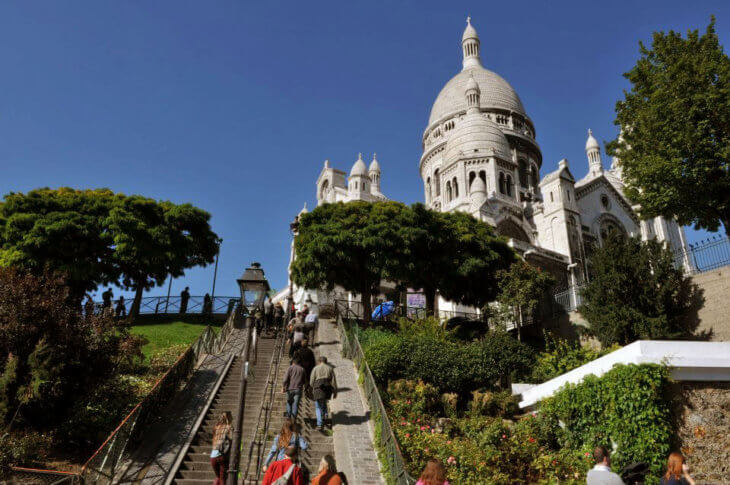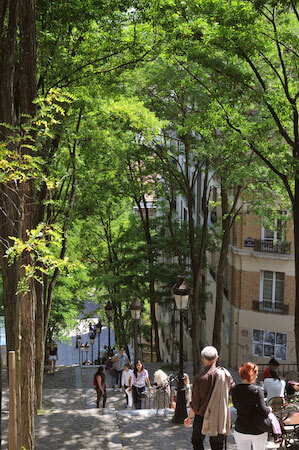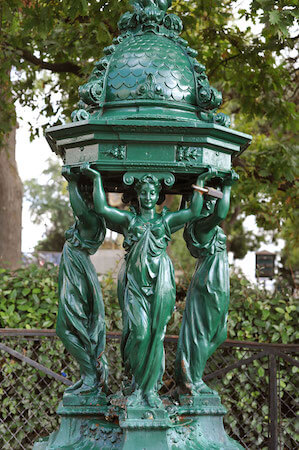The beautiful days have returned to Paris, and the hill of Montmartre has dropped any pretense of tranquillity and put on its summer game face. In the Place du Tertre, portraitists and local painters are now sharing the space with the terraces of the sweetly-named bars like Tartempion or Aux Cadets de Gascogne. It’s the perfect time to retrace the evolution of this very arty quartier.

A little more than a hundred years ago, these terraces were full of artists of all stripes in animated discussion over the issues of the day before they headed to the burlesques in the cabarets or the dances that attracted Parisians from all over each week. Montmartre was foremost a village of gardens and roughly-constructed wooden buildings cheap enough to attract so many of these artists, musicians, dancers, and actors.

To relive those good times, head North from the Place du Tertre toward the water tower, and find the small rue Cortot and the Museum of Montmartre. Situated in two lovely buildings, one dating from the 17th century, when it belonged to an actor from Molière’s troupe, it’s surrounded by gardens extending to the famous Montmartre vineyards (famous yards, infamous wine).
In these buildings that are now the museum, many artists lived and created: Renoir had his studio here between 1875 and 1877 where he painted some of his most famous paintings including the Moulin de la Galette. Also here was Le Père Tanguy, a paint grinder who took payment in the form of paintings, much to the chagrin of his wife, and was the first to sell a work by Van Gogh. He became a big booster of the Impressionists and was immortalized in three portraits by Van Gogh.

Suzanne Valadon was a model and painter and lived here too, with her son Maurice Utrillo and her lover. The apartment they occupied and her studio has been recently renovated, with the help of decorator Jacques Garcia. Through her workshop’s large, bright windows, you’ll discover a broad view stretching north to the plain of Saint-Denis.
Inside the museum, you’ll also see works painted for the cabarets, like the Black Cat and the Lapin Agile. You’ll immediately recognize the original Toulouse-Lautrec paintings made ubiquitous in posters everywhere, depicting the Montmartre way of life in a style innovative for their time.
The floors have retained their old tiles and windows, including their old frames. A zinc bar recovered from a nearby bistro recreates the atmosphere so well it only needs the waitress from a Monet painting to make the illusion complete.
The time has stopped in this private museum, and it’s not yet on the map of large tour groups. Enjoy the peace and tranquility of it now.
Montmartre is still an artist’s haven. In the early 20th century, a new building, nicknamed the Bateau-Lavoir, served as a workshop and home to a slate of prestigious artists: Juan Gris, Gauguin, Van Dongen, Modigliani, Brancusi, and Picasso, who painted Les Demoiselles d’Avignon there.
And despite a fire in the 1970s that led to a renovation, this place continues the tradition and is still used as a residence for contemporary artists, thanks to the City of Paris. It is closed to the public, unless you are lucky enough to be invited inside by one of its artists, such as photographer Christophe Beauregard.
Nearby, two other galleries support young artists: Jeune Création and the Kadist Foundation (which operates between Paris and San Francisco). They’re great places to discover what artists are doing now, that tourists will remember nostalgically a hundred years from now.
It’s not all tourism in Montmartre. If you head away from the Place du Tertre and browse Avenue Junot, you’ll begin seeing the trendy neighborhood enjoyed by young Parisians today. Avenue Junot was planned and constructed in 1910 and is home to buildings in the art deco style, along with small adjoining alleys lined with village houses. It’s a lovely change of scene. And stop into the Marcel café terrace to enjoy the vibe.
Heritage lovers are so lucky that the presence of underground quarries prevented the construction of high-rise buildings across the hill and allowed the village atmosphere to prevail across the centuries.
And one more hidden gem to search out: Austrian architect Adolf Loos built a notable building for the surrealist poet Tristan Tzara. And right next door on Avenue Junot is the Hotel Particulier Montmartre: a small hotel situated in the heart of a garden — worth a visit for an exceptional stay or just a tea break or a Sunday brunch.
Written by our Paris Network Developer, Krystal Kenney
Comment (0)